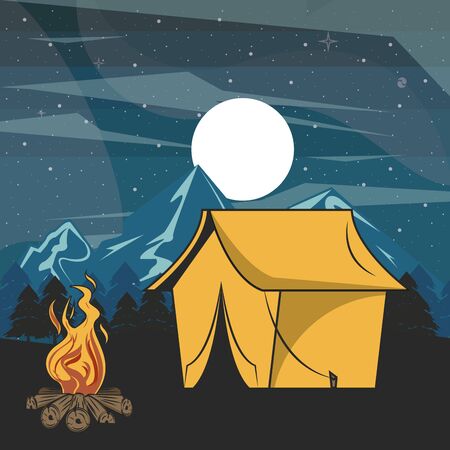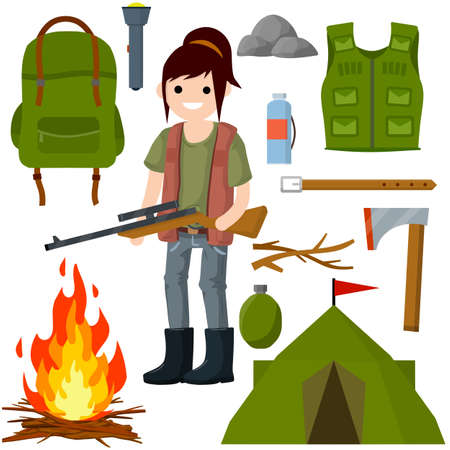1. Understanding Fire Restrictions and Local Laws
Before you even think about lighting a campfire, it’s crucial to understand the fire regulations in the area you plan to visit. Wildfires are a serious concern across the United States, especially during dry seasons, so both national and state parks enforce strict rules to keep everyone safe.
Check Fire Danger Levels
Fire danger levels can change daily depending on weather conditions like heat, humidity, and wind. Most parks post daily updates at ranger stations or entry points. You can also find this information online through park websites or apps like Smokey Bear’s Fire Danger Map.
Common Fire Danger Levels:
| Level | Description | What It Means for Campers |
|---|---|---|
| Low | Fires unlikely; cool and wet conditions | Campfires generally allowed with caution |
| Moderate | Fires possible if precautions arent taken | Use designated fire rings and never leave fires unattended |
| High | Fires likely to start easily and spread quickly | Avoid campfires unless absolutely necessary; follow all rules strictly |
| Very High / Extreme | Fires will start easily, spread rapidly, and be hard to control | No campfires allowed; use stoves only if permitted |
Respect Burn Bans and Local Regulations
During times of high fire risk, burn bans are often issued by local authorities. These bans may prohibit all open flames—including campfires, charcoal grills, and sometimes even portable gas stoves. Ignoring these rules could lead to fines or worse, cause a wildfire.
Where to Check Fire Restrictions:
- National Park Service (NPS): Visit nps.gov
- Bureau of Land Management (BLM): Check blm.gov
- State Park Websites: Each state has its own park system site with updated info
- Local Ranger Stations: Always ask when checking in or picking up permits
- Call 1-800-RED-FLAG (in some states): For updated fire restriction info by phone (availability varies)
Don’t Assume – Always Ask or Look It Up!
Laws can vary not just by state but even within different areas of the same forest or park. One campground might allow fires in designated pits while another nearby does not. When in doubt, ask a ranger or look up the latest fire safety info before striking that first match.
Being informed is the first step toward responsible camping. Know before you go—it’s not just smart, it could save lives.
2. Choosing the Right Campsite for a Safe Fire
Picking the right spot for your campfire is one of the most important steps to staying safe in the wild. A poorly placed fire can easily spread and become dangerous, especially in dry or windy conditions. Heres what you need to know when selecting a safe location for your campfire.
Keep a Safe Distance
Always place your fire at least 15 feet away from tents, gear, trees, shrubs, and anything else that might catch fire. This includes overhead hazards like low-hanging branches. It might seem like a hassle to walk a bit farther from your tent to get warm or cook food, but it’s worth it for safety.
Look for Existing Fire Rings
If youre camping in an established campground or popular backcountry area, there may already be designated fire rings or pits. These are usually marked with stones or metal rings and are designed to keep fires contained. Using these spots helps reduce environmental impact and increases safety.
How to Spot a Safe Fire Ring
| Feature | Why It Matters |
|---|---|
| Surrounded by rocks or metal ring | Keeps flames and embers contained |
| No flammable debris nearby | Reduces risk of fire spreading |
| Flat, clear ground | Makes the fire easier to control |
Avoid These Spots
- Under low tree branches or near dry grass
- On a slope where fire could move uphill quickly
- Too close to tents, chairs, or other gear
- In windy areas where sparks can travel far
Create Your Own Safe Fire Spot (If Allowed)
If there are no existing fire rings and fires are permitted in your area, you can build your own safe spot. Choose a level area on bare soil or gravel — never on roots, grass, or peat. Clear a 10-foot diameter around the site, removing all flammable material like leaves and twigs.
Quick Checklist Before Starting Your Campfire:
- [ ] At least 15 feet away from tents and trees?
- [ ] No low-hanging branches above?
- [ ] Using an existing fire ring if available?
- [ ] Ground is flat and clear of debris?
- [ ] Fire restrictions checked and followed?
Being thoughtful about where you set up your fire can make all the difference. Take your time to pick the right spot — it keeps you safe and helps protect nature too.

3. Building and Maintaining a Safe Campfire
Creating a campfire is part of the classic camping experience, but it’s important to do it safely and responsibly. Mastering the essentials—from using proper fire-starting materials to keeping the flame under control—can help prevent wildfires and ensure everyone stays safe.
Choose the Right Location
Before you strike a match, make sure your fire is in the right spot. Always use designated fire rings or pits when available. If none are provided, choose a flat, open area away from tents, trees, dry grass, or anything flammable. Clear at least 10 feet around the fire site.
Fire Site Checklist:
| Requirement | Description |
|---|---|
| Distance from Tents | At least 15 feet |
| Away from Trees & Bushes | No overhanging branches or dry brush nearby |
| Flat Ground | No slopes or uneven surfaces |
| Wind Conditions | Avoid building fires on windy days |
Use Safe Fire-Starting Materials
The key to a safe fire is using proper materials. Stick with natural fire starters like dry twigs, leaves, and small sticks (known as tinder). Never use gasoline, lighter fluid, or aerosol sprays—theyre dangerous and can lead to uncontrollable flames.
Recommended Fire-Starting Materials:
- Tinder: Dry leaves, pine needles, newspaper
- Kindling: Small sticks no thicker than your thumb
- Fuel Wood: Larger logs for sustained burning
Keep It Manageable
Your campfire should be just big enough for cooking or warmth. A smaller fire is easier to control and less likely to get out of hand. Stack wood in a teepee or log cabin shape to allow airflow while keeping the blaze contained.
Tips for Flame Control:
- Add wood slowly—don’t pile it on all at once.
- Aim for flames no higher than knee-level.
- Never leave your fire unattended.
Stay Ready with Safety Tools
You should always have tools nearby to manage or extinguish your fire. Keep a bucket of water, a shovel, and even a fire extinguisher if possible within reach. These simple tools can make all the difference if things go wrong.
Your Campfire Safety Kit:
| Tool | Purpose |
|---|---|
| Buckets of Water | Douse flames quickly if needed |
| A Shovel | Scoop dirt or sand onto the fire to smother it |
| A Fire Extinguisher | An added safety layer in case of emergency |
The key takeaway here? Keep it small, stay alert, and be prepared. A safe campfire not only makes your trip more enjoyable—it protects nature and everyone around you too.
4. Extinguishing Fires Properly
Putting out your campfire the right way is just as important as starting it safely. A fire that looks like its out can still hold heat and reignite hours later, especially in dry or windy conditions. Heres a simple guide to make sure your fire is truly out before you leave your campsite or go to bed.
Step-by-Step: How to Completely Extinguish a Campfire
Follow these steps every time you put out a fire:
| Step | Description |
|---|---|
| 1. Let it burn down | Allow the firewood to burn completely to ash if possible. This makes it easier to extinguish and reduces leftover heat. |
| 2. Spread the coals and ashes | Use a stick or shovel to spread out the remaining coals and ashes, which helps them cool faster. |
| 3. Douse with water | Pour water slowly over the ashes and coals. Listen for hissing sounds — that means theres still heat being released. |
| 4. Stir and repeat | Use a stick or shovel to stir the wet ashes, then pour more water on them. Repeat this process until there’s no steam, sound, or heat. |
| 5. Check for heat | Cautiously hover the back of your hand over the ashes (without touching). If you feel warmth, keep adding water and stirring. |
| 6. Final check | The area should be cold to the touch, wet, and free of any smoke or embers before you consider it safe. |
What Not to Do When Putting Out a Fire
- Dont bury your fire: Covering it with dirt can insulate hot coals, allowing them to smolder and reignite later.
- Don’t leave without checking: Always do a final hand-check for heat before walking away from your fire pit.
- Avoid using sand alone: Sand doesnt cool down embers — it can trap heat instead of removing it.
Helpful Tip:
If youre camping in a remote area where water is limited, plan ahead by bringing extra water just for extinguishing fires, or consider using a portable fire pit with better control over embers and cleanup.
Remember:
A fire isn’t truly out until its cold enough to touch safely. Taking those extra few minutes ensures youre doing your part to prevent wildfires and protect our natural spaces.
5. What to Do in Case of an Emergency
Even with the best preparation, accidents can happen. If your campfire starts to get out of control, it’s crucial to act quickly and calmly to keep yourself, others, and the environment safe. Here’s what you need to know if a fire emergency occurs while youre camping in the wild.
Step-by-Step Actions in a Fire Emergency
If a campfire spreads or becomes unmanageable, follow these steps immediately:
| Step | Action |
|---|---|
| 1 | Alert Others: Shout to notify everyone nearby that theres a fire emergency. |
| 2 | Call 911: Use your phone to contact emergency services right away. Provide detailed location info if possible (GPS coordinates or closest landmarks). |
| 3 | Evacuate the Area: Grab only essentials and move upwind of the fire. Avoid going downhill where fire can spread faster. |
| 4 | Help Others: Make sure children, elderly campers, or anyone needing assistance gets out safely. |
| 5 | Avoid Driving Through Smoke: If leaving by vehicle, make sure roads are safe and not covered by smoke or flames. |
Important Tips to Remember
- Stay Calm: Panic can lead to poor decisions. Take deep breaths and focus on getting to safety.
- Know Your Location: Before your trip, familiarize yourself with the area and note escape routes or ranger stations.
- Keep Emergency Supplies Ready: A pre-packed bag with water, flashlight, map, first-aid kit, and a whistle can be lifesaving.
If Youre Trapped by Fire
If evacuation isn’t possible and you’re surrounded by fire:
- Find a cleared area with little vegetation—like a dirt road or rocky surface.
- Lie low to the ground and cover yourself with a wet cloth or jacket if available.
- Breathe through fabric to reduce smoke inhalation.
Your Safety Comes First
No gear is worth risking your life for. Always prioritize personal safety over belongings. Fires can escalate fast, so knowing how to respond quickly can save lives.
Pro Tip:
Add local emergency contact numbers into your phone before heading out on any camping trip—especially if youll be in remote areas where cell service may be limited.
The key to surviving a fire emergency in the wild is preparation, quick thinking, and knowing when—and how—to get help.

